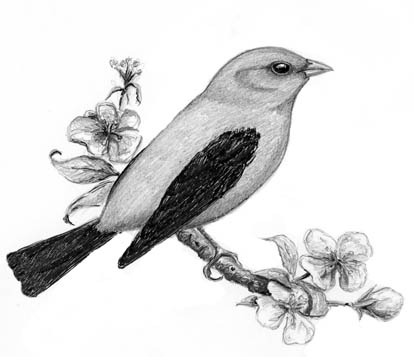
Dear Bird Folks:
Last week you helped a woman who wanted to find Wood Ducks. Perhaps you can help me too. I haven’t seen a Scarlet Tanager since I was a kid and that was a very long time ago. Do you have any suggestions where I might find one? I’d like to see one again, before too many more summers pass.
-Ethel, Sandwich
Oh Ethel,
That was one of the sweetest notes that I’ve received in a long time. I too have fond memories of seeing a Scarlet Tanager as a child. I still remember hearing my mother yelling for us to come see the tanager that was visiting our backyard. Even as a punk kid, I knew it was a pretty cool bird.
There are a few birds that leave a lasting impression the first time we see them. To me, Scarlet Tanagers are such birds. Other birds that fit into this unique category are hummingbirds, perhaps loons and, of course, Big Bird.
Believe it or not, the striking bird that we call a Scarlet Tanager is a fairly dull bird compared to some of the other members of its family. There are over 230 different species of tanagers living in South America. Most of them have color combinations that defy description. Grouped together, in a family portrait, a poster of tanagers would look like spin art with beaks.
Out of all of those hundreds of different tanagers, only two, the Scarlet and the Summer Tanager, are clever enough to leave the tropics to breed in eastern North America. The rest of them are content to stay in South America and tease monkeys.
It should be noted that it is only breeding plumage males that have the signature red color. Males in the fall and winter look like the females, which are a subtle greenish yellow.
The best way to see Scarlet Tanagers, Ethel, is to go out and buy yourself several hundred acres of oak forest. Then, don’t let anybody spray it or chop it down to build mini-malls. Tanagers seem to do the best in unfragmented oak forests. Deep woods protect the tanagers from the parasitic cowbird, which just loves to drop its eggs in tanager nests.
If you aren’t in the mood for buying up an entire oak forest, then the next best thing for you to do is to learn the tanager’s song. Scarlet Tanagers are more common than most of us think, but once the leaves come out in the spring, they become nearly invisible in the dense foliage. Tanagers sing constantly, so once you identify their call, you should be able to track down the bird.
Peterson describes their song as a series of short raspy phrases, singing “hurry, worry, flurry, blurry”. I guess that made sense to him. Peterson also said that the tanager’s song is very similar to the robin’s. But as the robin’s song is bright and cheery, the tanager sounds like it is suffering from a sore throat or cold; although I’m sure it really doesn’t have a cold, probably just allergies.
Learning bird calls via news print is difficult at best. Reading “hurry, flurry, tummy”, or whatever that was, is not much help. But there are several audio CD guides that make mastering bird calls almost bearable. A CD set (or cassette) called “Birding by Ear” is an excellent learning tool. In the case of the tanager and the robin, the CD plays both bird calls, one after another, and provides a clever narrative to help you learn the difference between the two birds.
Around here, your best chance at seeing tanagers is in early May, when the birds are stopping on migration and before the foliage becomes too dense. Cape Cod does have a small nesting population of Scarlet Tanagers, but for the most part our remaining woodlands are much too fragmented to attract them. Once again, you’ll have better luck if you take a drive off Cape. The area around the Quabbin Reservoir might be a good place to start. Just don’t spit in the water, the people in Boston get mad.
I wish I could give you a more definite place to find tanagers Ethel, but unlike terns and gulls, nesting songbirds can be a challenge to find. If all else fails, you could take a trip to South America: they are knee deep in tanagers down there. Heck, you might even get a chance to tease monkeys.